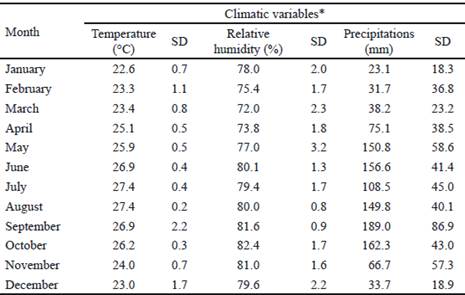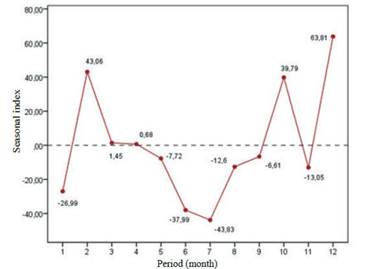Introduction
Fascioliasis is currently recognized as one of the most important parasitic diseases in cattle. Fasciola sp. in addition to being one of the main causes of liver discards in slaughterhouses, it implies other damages associated with the infection: decrease in the production of meat, milk or wool and body weight; infertility, decreased growth, reproductive delay, abortions and loss of resistance to other diseases. Costs increase due to anthelminthic treatments, as well as frequent secondary bacterial infections, which can cause the animals death (Martínez-Surós et al. 2013, Kialanda et al. 2013 and Molento et al. 2018).
When considering that the development and survival of larval stages in the grass depend on precipitations, relative humidity and temperature (Ticona et al. 2010), in Cuba there are conditions that promote the development of this parasitic disease as the existence of two well-defined climatic periods (dry and rainy). The performnace of grass and animal infestations fluctuates depending on these conditions (Arece and Rodríguez 2004).
In Camagüey province, Arteaga (2014) concluded that there is variability in the prevalence of F. hepatica in different years and municipalities, due to the variation of climatic factors, mainly the average precipitation. These authors proposed the use of neural networks for the prognosis of prevalence in the slaughterhouse, but did not define the existence of seasonal patterns. Subsequently, Palacio et al. (2017) reported the existence of a seasonal pattern for the affected cattle by this parasitosis.
The objective of this study was to determine seasonal patterns for economic losses induced by Fasciola hepatica in slaughtered cattle in Camagüey province.
Materials and Methods
The study was conducted from records of cattle slaughtered during the period between January 2008 and December 2014 (13 059 cases) in the industrial slaughterhouse "Chacuba", Unidad Básica de la Empresa Comercializadora de Ganado Terso, belonging to Maraguán livestock, Camagüey, Cuba.
The monthly data corresponding to the discarded livers (kg) were used. For each discarded liver, an average weight of 4 kg was considered (González et al. 2007) and the value of 0.90 Cuban convertible pesos/ kg, which is the price normally used by the enterprise. The estimation of the amount of losses (only the livers discard was considered) was performed by the following equation:
Where:
TEL |
Total economic losses (kg) |
a |
Affected livers (unit) |
b |
Total kg of recovered livers |
c |
Total kg of discarded livers |
Statistical analysis. The data were processed following a chronological series analysis, from which the year variables were monthly obtained (12 months).
Taking into account the performance of the monthly pattern of losses due to discard, the seasonal decomposition process was executed with the following additive model:
Yt |
Time series for the variables slaughtered animal, affected animals, proportion of affected animals and the amount of losses due to discards |
Tt |
Trend (T) |
Ct |
Cycles o cyclicity (C) |
St |
Seasonal (S) |
Rt |
Residual component |
The analyses were carried out according to the Statgraphics Centurion XVI package version 16.1.18 (Statpoint Inc. 1982-2012).
Results and Discussion
Table 1 shows that 2008, 2009 and 2010 had higher losses produced by F. hepatica with respect to the rest of the years of the series.
In economic terms, fascioliasis is probably the most important helminths infection. Causing high economic losses in many parts of the tropics, due to its incidence in productive animals such as cattle, sheep, goats and buffalo, with an estimated loss of up to three billion dollars a year (Kialanda et al.2013, González 2014 and Hassan et al. 2014, Moscoso 2014 and Selemetas 2015).
The pathological changes in the liver can be seen in the acute or chronic phases of the disease. To this must be added the losses produced by the organ discarded in the slaughterhouse, classified as of low quality (Palacio et al. 2017).
There are numerous studies carried out to show that the economic effect of fasciolosis is remarkable. Whenever the disease is present with endemic characteristics under favorable environmental conditions, it is sufficient reason to support the need for its prevention and control in livestock (Palacio et al. 2017).
Pattern of seasonal performance. A seasonal performance pattern was obtained for the total economic losses due to discards of affected liver by F. hepatica, which was characterized by higher rates in the months of February, October and December (figure 1).
The average values for precipitations had an increase between May and October, while for temperature and relative humidity they remained stable throughout this period (table 2).
Table 2 Climatic variables (average values and standard deviation)

*Average values in 2008-2014 period
SD (standard deviation)
The climate has an effect on the stages of free life of the parasite and its intermediate host: Galba cubensi, with interactions between precipitation and temperature that exert a higher influence on the effectiveness of transmission (Vázquez et al. 2010 and Fox et al. 2011). The prevalence and economic impact of fasciolosis are related to the climatic and alimentary factors of the animals, which favor the persistence of the helminth's biological cycle (Palacio et al. 2017).
In a study carried out during four years in a Cuban livestock enterprise, economic losses of 16,121.30 Cuban convertible pesos were estimated, due to discarded livers affected by Fasciola; in addition to 316 078.38 and 170 664.60 Cuban convertible pesos, due to the estimation of not produced meat, and 14 686.18 Cuban convertible pesos for the use of anthelmintic. This is 517 550.46 Cuban convertible pesos in estimated total losses (León et al. 2013 and Kialanda et al. 2013).
In the central provinces, economic losses were assessed as considerable (436,656 Cuban convertible pesos) due to the livers discard in 18.0 % of the 273,450 slaughtered animals (González et al. 2007). In a study during four years, Brito (2010) estimated that fascioliasis affected one in three slaughtered cattle, with losses of 16,121.30 USD, due to the discarded livers; in addition to 316 078. 38 and 170 664. 60 USD, including the estimated production of non-produced beef, respectively.
Seasonal indices show the dependence of these findings with respect to climatic conditions (Giménez et al. 2014). The results obtained by Palacio et al. (2017) also coincide for the affected animals and the prevalence in the same studied period.
The use of models obtained for the prognosis of the animals affected by Fasciola hepatica, the economic losses and the prevalence with adequate fits in the estimation and validation, ratifies the validity of them. Therefore, it is recommended to evaluate the dynamics of intermediate hosts and the larval stages of F. hepatica to relate them with the seasonal patterns observed for the economic losses caused by the livers discard.











 texto en
texto en 






